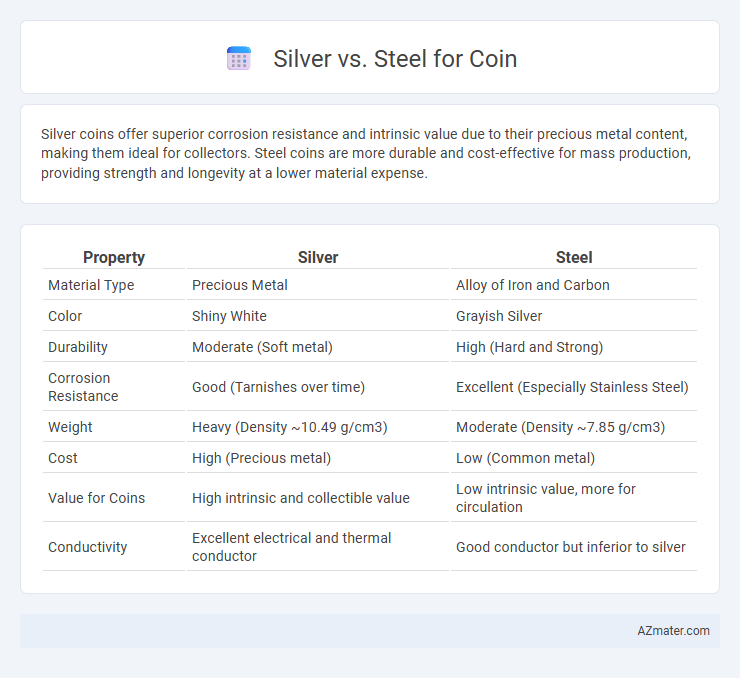Silver coins offer superior corrosion resistance and intrinsic value due to their precious metal content, making them ideal for collectors. Steel coins are more durable and cost-effective for mass production, providing strength and longevity at a lower material expense.
Table of Comparison
| Property | Silver | Steel |
|---|---|---|
| Material Type | Precious Metal | Alloy of Iron and Carbon |
| Color | Shiny White | Grayish Silver |
| Durability | Moderate (Soft metal) | High (Hard and Strong) |
| Corrosion Resistance | Good (Tarnishes over time) | Excellent (Especially Stainless Steel) |
| Weight | Heavy (Density ~10.49 g/cm3) | Moderate (Density ~7.85 g/cm3) |
| Cost | High (Precious metal) | Low (Common metal) |
| Value for Coins | High intrinsic and collectible value | Low intrinsic value, more for circulation |
| Conductivity | Excellent electrical and thermal conductor | Good conductor but inferior to silver |
Introduction: Silver vs Steel Coins
Silver coins offer higher intrinsic value due to their precious metal content, making them a preferred choice for collectors and investors seeking tangible wealth. Steel coins, on the other hand, provide durable, cost-effective alternatives primarily used for everyday circulation, benefiting from resistance to corrosion and wear. The choice between silver and steel coins depends largely on factors such as value retention, production cost, and intended use in numismatic or commercial contexts.
Historical Overview of Coinage Materials
Silver has been a preferred coinage material since ancient civilizations such as the Greeks and Romans due to its intrinsic value and durability, often representing wealth and stability in economies. Steel emerged as a coinage metal primarily in the 20th century, especially during wartime periods like World War II, when shortages in precious metals prompted governments to adopt more abundant and cost-effective materials. Historical shifts from silver to steel coins reflect evolving economic conditions, technological advancements in metallurgy, and the need for practical currency solutions during resource-scarce times.
Physical Properties: Silver and Steel Compared
Silver boasts a density of 10.49 g/cm3, making it heavier than steel, which typically ranges from 7.75 to 8.05 g/cm3 depending on its alloy composition. Silver's softness with a Mohs hardness of 2.5 to 3 allows easy engraving but increases wear risk, whereas steel's hardness varies from 4 to 8, providing superior durability for coins. Thermal conductivity in silver at 429 W/m*K far exceeds steel's average near 50 W/m*K, affecting heat dissipation during coin minting processes.
Durability and Wear Resistance
Steel coins exhibit superior durability and wear resistance compared to silver, making them more suitable for high-circulation currency. Silver, while aesthetically appealing and resistant to corrosion, is softer and more prone to scratches and deformation over time. The hardness of steel alloys enables coins to maintain their design details and structural integrity far longer under frequent handling.
Aesthetic Appeal and Design Versatility
Silver coins exhibit a lustrous, bright finish that enhances the intricate details of coin designs, making them highly prized by collectors and investors for their visual appeal. Steel coins offer greater design versatility due to their durability and ease of manufacturing, allowing for a wider range of textures and finishes without compromising longevity. While silver lends a classic elegance with its natural sheen, steel provides contemporary, practical designs that maintain aesthetic quality under heavy circulation.
Value and Investment Potential
Silver coins offer intrinsic value due to their precious metal content, maintaining a stable market price influenced by global silver demand and supply dynamics. Steel coins, typically used for lower denominations, lack precious metal value and are more susceptible to corrosion, making them less suitable for long-term investment. Investors looking for tangible asset growth tend to prioritize silver coins for their combination of historical significance and potential appreciation in value.
Corrosion and Tarnish: Maintenance Considerations
Silver coins, while prized for their luster, are more prone to tarnish due to sulfur compounds in the air reacting with the silver surface, requiring regular cleaning to maintain their shine. Steel coins, often coated with a protective layer such as zinc or chrome, exhibit greater resistance to corrosion and tarnish but may still rust if the protective coating is damaged or worn. Proper storage in low-humidity environments and minimal handling can significantly reduce the maintenance needed for both silver and steel coins.
Production Costs and Economic Impact
Silver coins incur higher production costs due to the metal's market value and more complex refining processes, leading to increased minting expenses compared to steel. Steel coins offer significant cost savings with lower raw material prices and simpler manufacturing, making them economically viable for high-volume circulation. The choice between silver and steel directly impacts coin durability, consumer acceptance, and the long-term financial sustainability of minting operations.
Collectibility and Rarity Factors
Silver coins hold greater collectibility and rarity value due to their limited mintage and intrinsic metal worth, often attracting investors and numismatists seeking tangible assets. Steel coins are typically mass-produced for circulation with lower metal value, resulting in less appeal among collectors compared to scarce silver issues. The premium on silver coins can significantly increase based on historical context, mint marks, and condition, enhancing their desirability in the numismatic market.
Environmental and Ethical Considerations
Silver coins often have a smaller environmental footprint than steel due to lower energy requirements in mining and refining processes. Ethical considerations favor recycled silver, which reduces the demand for new mining and associated community disruptions, while steel production generally involves more extensive mining and higher CO2 emissions. The choice between silver and steel coins hinges on balancing environmental impact, with recycled silver presenting a more sustainable and ethically responsible option.

Infographic: Silver vs Steel for Coin
 azmater.com
azmater.com